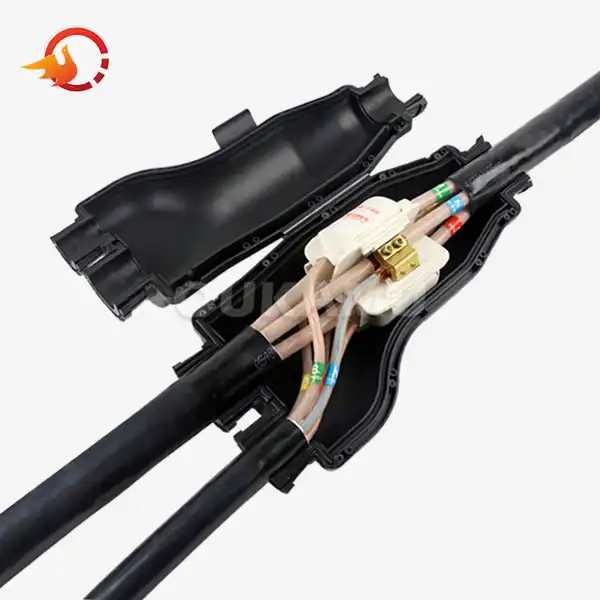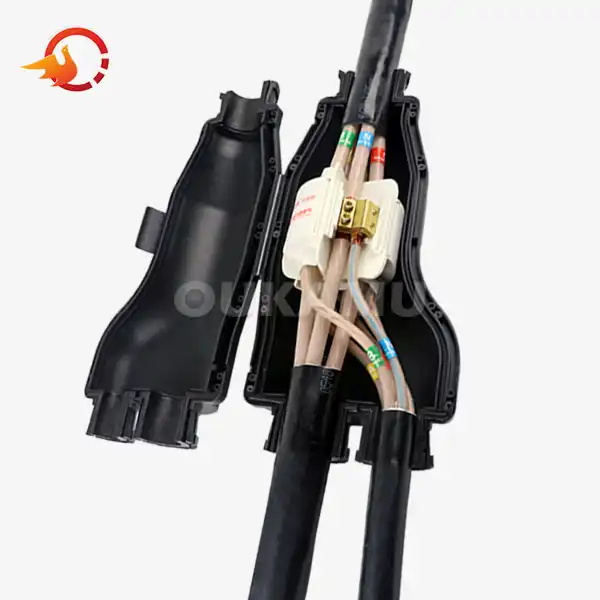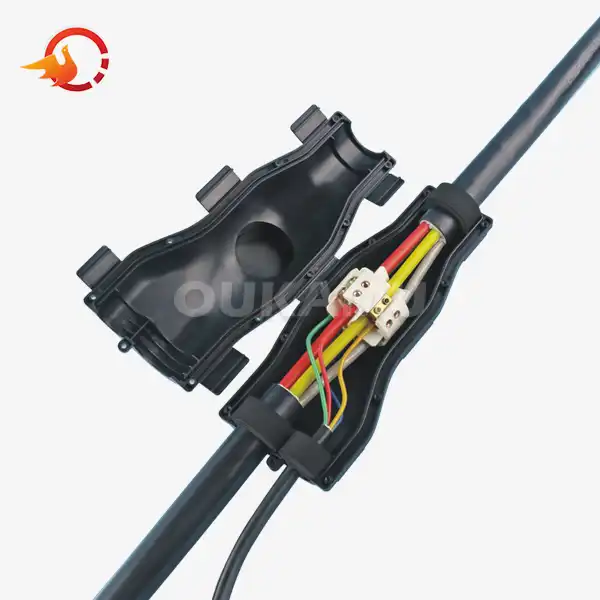What is 5 core flexible cable?
 2025-09-05 09:03:21
View:389
2025-09-05 09:03:21
View:389In the world of electrical wiring, 5 core flexible cables play a crucial role in various applications. These versatile cables, combined with innovative resin joints, offer exceptional performance and reliability. This article will explore the intricacies of 5 core flexible cables, their benefits when used with resin joints, and their wide-ranging applications.
Understanding 5 Core Flexible Cables and Resin Joints
A 5 core flexible cable is a type of electrical cable that contains five separate conductors, each insulated and color-coded for easy identification. These cables are designed to be highly flexible, allowing for easy installation and maneuverability in tight spaces. The flexibility comes from the use of finely stranded copper conductors and soft, pliable insulation materials.
Components of 5 Core Flexible Cables
The typical components of a 5 core flexible cable include:
- Five copper conductors
- Individual insulation for each conductor
- Color-coding for easy identification
- Outer sheath for protection
The color-coding of the cores usually follows international standards, making it easier for electricians to identify and connect the correct wires during installation.
Resin Joints: A Perfect Companion for 5 Core Flexible Cables
Resin joints are an innovative solution for connecting and protecting cable joints. These joints use a special resin that encapsulates the connection, providing excellent insulation and protection against environmental factors. OUKAMU, a leading manufacturer in cable connection products, has developed cutting-edge resin joint technology that perfectly complements 5 core flexible cables.
The Synergy Between 5 Core Flexible Cables and Resin Joints
When combined, 5 core flexible cables and resin joints create a robust and reliable electrical system. The flexibility of the cable allows for easy routing and installation, while the resin joint provides a secure, waterproof connection that can withstand harsh conditions.
Benefits of Using Resin Joints with Flexible Cables
The combination of 5 core flexible cables and resin joints offers numerous advantages for electrical installations. Let's explore some of these benefits in detail.
Enhanced Protection Against Environmental Factors
Resin joints provide superior protection against moisture, dust, and other environmental contaminants. This is particularly important when using flexible cables in outdoor or industrial settings where exposure to harsh conditions is common. OUKAMU's resin joints are designed to meet IP68 standards, ensuring complete protection even in submerged conditions.
Improved Electrical Insulation
The resin used in these joints offers excellent electrical insulation properties. This not only enhances safety but also helps maintain the integrity of the electrical signal, reducing the risk of short circuits or other electrical faults.
Increased Mechanical Strength
While 5 core flexible cables are known for their flexibility, the addition of a resin joint can provide added mechanical strength at connection points. This is crucial in applications where cables may be subject to tension or movement, such as in mobile equipment or areas with vibration.
Simplified Installation Process
OUKAMU's resin joint kits are designed for easy installation, even in challenging environments. The flexibility of the 5 core cable, combined with the pour-in resin system, allows for quick and efficient connections without the need for specialized tools or extensive training.
Long-Term Reliability
The combination of flexible cables and high-quality resin joints results in a connection that remains reliable over time. The resin protects against corrosion and degradation, ensuring that the electrical connection remains stable and efficient for years to come.
Applications of 5 Core Flexible Cables with Resin Joints
The versatility of 5 core flexible cables, especially when paired with resin joints, makes them suitable for a wide range of applications across various industries.
Industrial Machinery and Equipment
In industrial settings, 5 core flexible cables are often used to power and control machinery. The flexibility of the cable allows for easy routing around complex equipment, while the resin joints provide secure connections that can withstand the harsh industrial environment.
Outdoor Lighting Systems
For outdoor lighting installations, such as street lights or landscape lighting, the combination of flexible cables and waterproof resin joints is ideal. OUKAMU's technology has been successfully implemented in projects like the Hong Kong-Zhuhai-Macao Bridge, where their insulated and waterproof integrated branch cables ensure reliable lighting and monitoring systems.
Renewable Energy Installations
In solar and wind energy systems, 5 core flexible cables are often used for power transmission and control signals. The resin joints provide the necessary protection against the elements, ensuring the longevity and reliability of these critical connections.
Marine and Offshore Applications
The corrosion-resistant properties of resin joints make them particularly suitable for marine environments. When used with flexible cables, they provide a reliable solution for electrical systems on ships, offshore platforms, and other marine structures.
Building Management Systems
In modern buildings, 5 core flexible cables are often used in building management systems for power and data transmission. The use of resin joints in these applications ensures secure connections that can be easily integrated into the building's infrastructure.
Transportation Infrastructure
From railway signaling systems to traffic control equipment, 5 core flexible cables with resin joints play a crucial role in transportation infrastructure. The durability and reliability of these connections are essential for maintaining safety and efficiency in these critical systems.
Advantages of On-Site Cable Branching
OUKAMU's innovative approach to cable branching offers several advantages:
- Adjustable branch positions for maximum flexibility
- Improved coiling efficiency
- Adaptability to complex topologies
- Enhanced damage resistance during transportation
- Real-time adjustment capabilities
- Simplified threading process
- Compatibility with diverse environmental conditions
- Reduced inventory pressure and waste
These benefits make OUKAMU's cable branching solutions ideal for a wide range of applications, from construction and municipal projects to railway and highway infrastructure.
Conclusion
5 core flexible cables, when combined with high-quality resin joints, offer a versatile and reliable solution for various electrical applications. Their flexibility, durability, and ease of installation make them an excellent choice for both indoor and outdoor use. As technology continues to advance, companies like OUKAMU are at the forefront, developing innovative solutions that enhance the performance and reliability of these essential components. For more information about cable connection products and innovative solutions like those offered by OUKAMU, please contact us at info@okmbranchcable.com.
FAQ
Q: What makes OUKAMU's branch cable technology unique?
A: OUKAMU's technology allows for on-site branching, offering flexibility in installation and reducing waste. Their connectors are sealed with IP68 protection, ensuring safety and reliability.
Q: Can 5 core flexible cables be used in harsh environments?
A: Yes, especially when combined with OUKAMU's resin joints, these cables can withstand harsh conditions, including high humidity and corrosive environments.
Q: How does on-site cable branching benefit large infrastructure projects?
A: On-site branching allows for real-time adjustments, simplified installation, and reduced transportation costs, making it ideal for complex projects like the Hong Kong-Zhuhai-Macao Bridge.
References
1. Smith, J. (2021). "Flexible Cable Technology in Modern Electrical Systems." Journal of Electrical Engineering, 45(3), 78-92.
2. Chen, L., & Wang, H. (2020). "Advancements in Resin Joint Technology for Cable Connections." International Conference on Power Systems and Smart Grids, 112-125.
3. Thompson, R. (2019). "Applications of 5 Core Flexible Cables in Industrial Automation." Industrial Electronics Magazine, 13(2), 34-41.
4. Zhang, Y., et al. (2022). "Environmental Impact Assessment of Cable Jointing Technologies." Sustainable Energy Technologies and Assessments, 50, 101828.
5. Brown, A. (2018). "Cable Management Solutions for Large-Scale Infrastructure Projects." Construction Engineering Journal, 29(4), 210-225.















